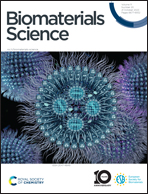Multifunctional calcium polyphenol networks reverse the hostile microenvironment of trauma for preventing postoperative peritoneal adhesions†
Abstract
Abdominal adhesions, a commonly observed complication of abdominal surgery, have a high incidence and adversely affect patients’ physical and mental health. The primary causes of abdominal adhesions are intraoperative trauma, acute inflammatory response, bleeding, and foreign body infection. Because most current treatment approaches for abdominal adhesions are limited, improved and novel postoperative anti-adhesion regimens are urgently needed. In this study, we developed calcium polyphenol network (CaPN) microspheres based on the self-assembly of the natural triphenolic compound gallic acid and Ca2+ in solution. The physicochemical properties of CaPNs, including their hemostatic, antibacterial, antioxidant, and anti-inflammatory activities, were investigated in vitro. Bleeding and cecal-abdominal wall adhesion models were established to observe the hemostatic activity of CaPNs and their preventive effect on postoperative abdominal wall adhesion in vivo. The results showed that CaPNs significantly reduced inflammation, oxidative stress, fibrosis, and abdominal adhesion formation and had good hemostatic and antibacterial properties. Our findings suggest a novel strategy for the prevention of postoperative adhesions.



 Please wait while we load your content...
Please wait while we load your content...